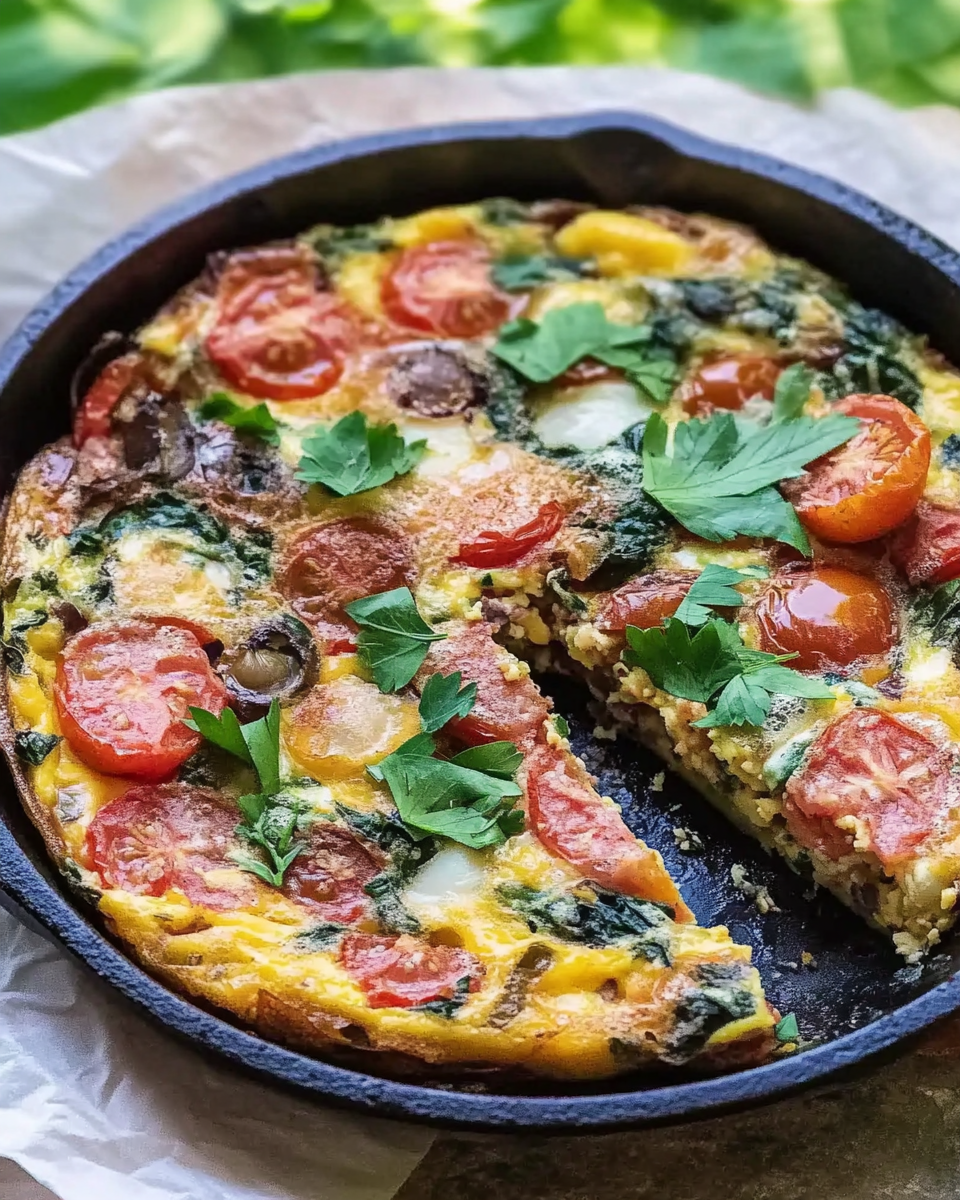Why the Frittata Is the Perfect Seasonal Dish
Frittatas are beloved for their versatility and ease, but what makes this particular recipe special is its celebration of seasonal vegetables and herbs. Late summer is the perfect time for tomatoes at their peak of ripeness, offering a sweet, juicy burst of flavor. When cooked just right, the tomatoes blister and soften, releasing their natural juices that infuse the dish with richness and freshness.
The addition of caramelized shallots introduces a subtle sweetness and depth that complements the bright acidity of the tomatoes. Fresh herbs like parsley, dill, or basil provide aromatic notes that elevate the flavor profile and lend a fresh, green vibrancy. Combined with nutrient-dense leafy greens such as arugula or spinach, the dish captures the essence of the season in every bite.
Nutritional Powerhouse: Protein and Vitamins in Every Slice
One of the standout features of this frittata is its impressive nutritional profile. Eggs are an excellent source of high-quality protein, containing all essential amino acids needed for muscle repair, immune function, and overall health. Pasture-raised eggs, in particular, offer enhanced nutrient density, including higher levels of omega-3 fatty acids and vitamins A and E.
The vegetables and herbs packed into this dish contribute a wealth of vitamins and antioxidants. Tomatoes are rich in vitamin C, potassium, and lycopene, a powerful antioxidant linked to heart health. Leafy greens like spinach and arugula provide iron, folate, and vitamins K and C, supporting everything from bone health to immune function. Shallots add flavor without extra calories, and fresh herbs boost antioxidant intake while enhancing taste.
Together, these ingredients create a well-rounded meal that nourishes both body and mind.
Dairy-Free and Paleo-Friendly: Inclusive and Wholesome
This recipe’s dairy-free nature makes it accessible to those who avoid dairy for health or ethical reasons, without sacrificing creaminess or flavor. The use of almond milk or other dairy alternatives ensures a tender texture and moisture in the eggs, while melted ghee, coconut oil, or olive oil adds richness and aids in cooking.
The frittata’s paleo-friendly profile also appeals to those following diets focused on whole, unprocessed foods. Its reliance on pasture-raised eggs, fresh vegetables, and healthy fats aligns well with paleo principles, offering a nutrient-dense and balanced dish.
Cooking Techniques: From Stove to Oven for Perfect Texture
The preparation of this frittata is designed to be straightforward yet effective. Caramelizing the shallots slowly over medium heat draws out their natural sweetness, creating a flavorful base. Allowing the tomatoes to blister without stirring encourages caramelization and intensifies their taste.
Wilted greens and fresh herbs are added just before the eggs, ensuring they retain their bright color and fresh flavor without becoming overly soggy. Pouring the egg mixture over the cooked vegetables and allowing the bottom to set on the stove before transferring to the oven ensures a firm base and even cooking.
Baking the frittata until the eggs are just set results in a tender, slightly custardy texture with no wobble, which is the hallmark of a perfectly cooked frittata. This method also ensures minimal hands-on time and even cooking without the risk of burning the base.
Versatility in Cooking Equipment and Presentation
This dish is remarkably adaptable and can be made in a cast iron skillet or a pie dish, depending on your kitchen tools and preference. A cast iron skillet offers the benefit of excellent heat retention and the ability to go straight from stovetop to oven, producing a beautifully browned crust and easy serving.
Using a pie dish allows for easy layering and slicing, which is perfect for entertaining or meal prep. The frittata can be served warm, at room temperature, or even chilled, making it suitable for a range of dining occasions—from leisurely weekend brunches to quick weeknight dinners.
Customization: Protein Additions and Flavor Variations
While this frittata shines as a vegetarian and dairy-free dish, it’s highly customizable. Adding proteins such as deli turkey, bacon, or sausage can turn it into a heartier meal for those who enjoy meat. Incorporating cheeses like goat cheese or feta adds tangy creaminess if dairy is not a concern.
Herbs can be varied based on personal preference or what’s fresh in the garden, with options such as chives, tarragon, or thyme offering different aromatic profiles. Adding spices like smoked paprika or chili flakes can provide warmth and complexity for a bolder flavor.
This flexibility allows cooks to tailor the dish to suit dietary needs, flavor preferences, and seasonal availability.
Serving Suggestions and Pairings
The Late Summer Frittata pairs wonderfully with simple sides that complement its fresh flavors. A crisp green salad dressed with lemon vinaigrette offers brightness and crunch, while roasted potatoes or grilled vegetables provide a heartier accompaniment.
For brunch or breakfast, serving with crusty bread or toasted sourdough is ideal. It also pairs well with fresh fruit or a light soup for a balanced meal.
Drinks like sparkling water with citrus, freshly brewed tea, or light white wine can round out the meal depending on the occasion.
Why This Frittata is Perfect for Seasonal Eating
Embracing seasonal produce is one of the most flavorful and sustainable ways to cook, and this frittata exemplifies that philosophy. It highlights the peak flavors of summer tomatoes and fresh herbs while incorporating nutrient-dense greens. By focusing on what’s fresh and available, the dish offers unparalleled taste and nutritional benefits.
Seasonal cooking also supports local farmers and reduces environmental impact, making this recipe not only delicious but conscientious.
Conclusion
The Late Summer Frittata with Tomatoes and Fresh Herbs is a fresh, savory dish that celebrates the vibrant flavors of the season. Combining tender pasture-raised eggs with ripe summer tomatoes, caramelized shallots, leafy greens, and fragrant herbs, this dairy-free frittata offers a wholesome and flavorful meal that suits any time of day.
Its simplicity in preparation, nutritional richness, and adaptability to different dietary preferences make it a go-to recipe for those seeking both comfort and freshness. Whether made in a cast iron skillet or pie dish, served warm or at room temperature, this frittata is an elegant yet easy way to honor seasonal produce and bring vibrant, healthy eating to your table.






